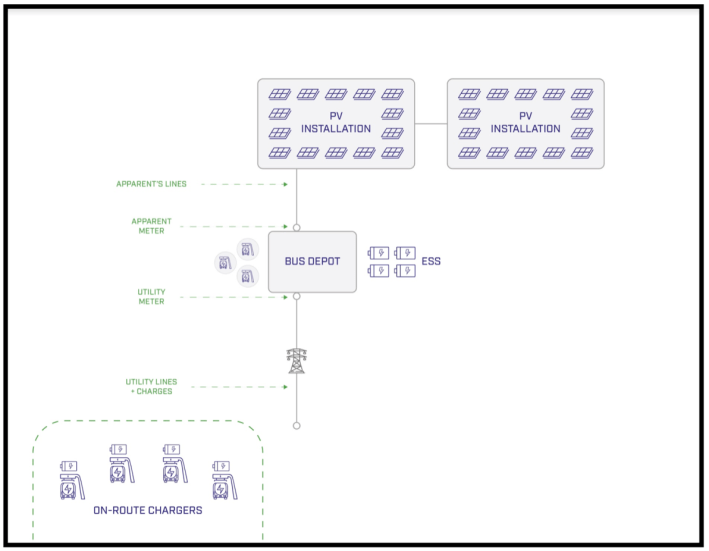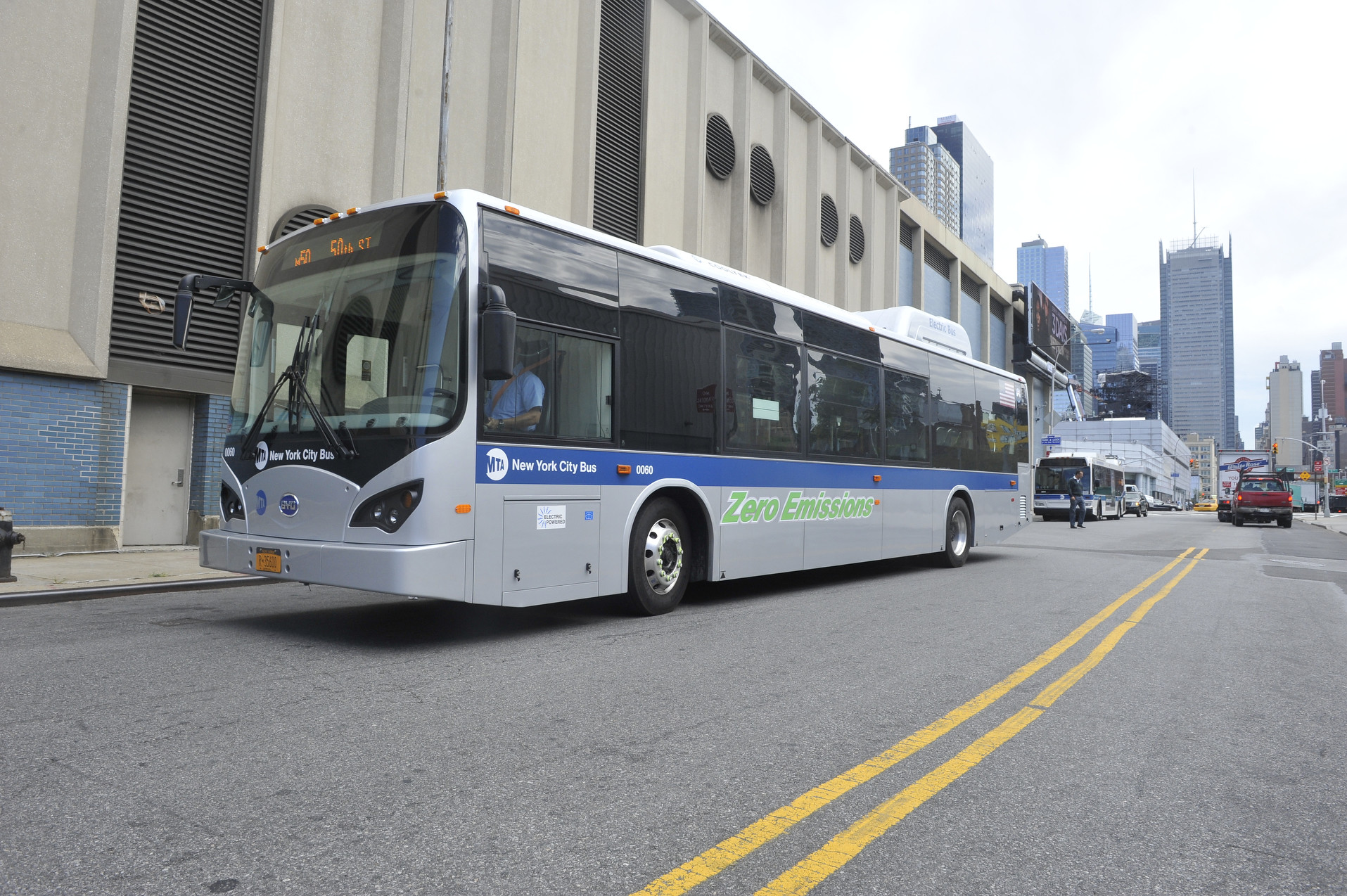A groundbreaking new technology may soon help U.S. transit agencies overcome perhaps the single largest barrier to electrifying bus fleets: creating on-route electric charging stations capable of affordably and quickly fueling up buses as soon they run out of power.
As bus manufacturers rush to invent an affordable lithium ion battery that can hold a charge long enough to cover long routes in sprawling U.S. cities without a trip back to the depot, Northern California-based startup, Apparent, is urging agencies to take a more proactive approach: by installing ultra-efficient miniature power stations along bus routes — equipped (of course) with the company's energy optimization technology.
These mini-hubs, called "distributed energy resources" by the energy industry, certainly aren't new; any bus stop with a solar panel on its roof to help riders charge their cell phones qualifies as one. But most distributed energy resources have struggled to meet the massive energy needs of the largest electric vehicles on the road — or to do it cheaply enough that agencies can afford to make use of them.
Apparent's tech helps solves that problem by, essentially, using a complex algorithm to dynamically tell its distributed energy resources exactly when to pull power from the micro-grid, or from storage, when the local power source is low on juice — and it uses artificial intelligence to do so in a sophisticated way that minimizes energy loss so much that even huge buses can charge up relatively cheaply, and with zero carbon output.
And if the company's product is as effective as it says, installing these networks of micro-power plants could help get more electric buses on America's streets — something that we've so far utterly failed to do.
The U.S. has just 650 e-buses in service nationwide — a pitifully small number that experts say has more to do with the logistical and financial challenges of charging e-buses than most Americans realize. China, by contrast, has 421,000 electric buses in operation right now — in large part because the country started its quest to become the undisputed electric buses capital of the world by optimizing the electric grid to charge its fleet.
Why it's so hard to charge an e-bus
To understand why the tech-enhanced microgrid model could be such a game changer for U.S. e-bus adoption, it's important to understand a few things about how electric buses work — or more accurately, how they don't work for the needs of American transit agencies, at least right now.
A long-range electric bus powered by a lithium ion battery requires a massive amount of power to keep on the road — but a battery-powered bus takes anywhere from two and a half to six hours to fully charge, rather than just a few minutes at the pump for its fossil fuel-powered cousin.
And even under optimal driving conditions, the amount of energy required to charge the popular Proterra e-bus battery, for instance, is comparable to the daily energy consumption of more than more than seven energy-guzzling American homes — and that massive charge can only carry the bus about 125 miles.
And again, that's under optimal conditions; steep hills, rough road surfaces, and heavy passenger loads can make e-bus batteries even more inefficient, cutting their driving range by as much as 24 percent and requiring mid-route charges that can keep a bus sidelined for hours.
Bus agencies in sprawling cities, meanwhile, often need their buses to cover far more distance in a day than the average battery life can manage — which means agencies need to rotate buses with depleted batteries out of service for hours, and rotate in fully charged buses to replace them. Duplicating fleets can get expensive fast — so expensive, in fact, that many agencies opt not to go green at all.
In 2018, for instance, Albuquerque Rapid Transit actually sent back 15 hard-won electric buses because the vehicles couldn't travel the 275 miles per battery charge that the manufacturer had advertised, and the agency couldn't run feasibly a bus service with vehicles that had a shorter range.
"We thought we’d put in charging stations in two or three different areas," said Albuquerque transportation spokesman Rick De Reyes. "But no matter how much spent, we needed at least 275 miles on a charge, and there is no battery out there, or series of batteries, or manufacturer, that can provide that currently."
Enter distributed energy resources
Most American transit leaders seem to be resigned to the sad reality that the e-bus batteries we have now just aren't up to the challenge of providing reliable bus service in American cities — and on-route charging stations are too expensive to implement broadly.
"Electric buses are not mature enough as a technology for cities to rely on them as a workhorse," TransitCenter spokesman Ben Fried told Streetsblog. "Agencies will save fuel cost in the long run, but you don’t want to roll out technology if it will hamper ability to provide service."
An affordable on-route charging model, though, could be a game changer for the e-bus industry — and like many groundbreaking innovations, the details of how we might achieve it are technical, utterly boring to a layman, and astoundingly crucial to the progress of mobility innovation.
"Electric buses have large batteries — and in essence, they are a large battery, even if they aren't always a perfect one," says Maggie Alexander, director of business development for Apparent. "So the first big challenge to transitioning to an electric fleet is ensuring that there’s enough charging capacity [along the route] to meet the charging demand — and that's especially challenging because the depots where agencies tend to charge these batteries now tend to be located in dense urban hubs, where it’s challenging and expensive to expand new infrastructure."

Apparent's technology optimizes energy consumption in two key ways.
First, like all distributed energy resources, Apparent's hubs use local power generation as a way to to minimize the costs inherent in transmitting energy from a faraway plant through through a wire — a process that costs a growing amount of money to U.S. consumers. That's because the further your power has to travel to reach your electric socket, the more power is lost along the way, and those losses are passed along to consumers. A 2018 report from the Clean Coalition found that "if current transmission costs grow by even 8 percent a year (a conservative assumption, given that transmission costs have seen close to 12.5 percent annual growth from 2008 through 2018), California ratepayers would pay a total $121 billion over 20 years to support CAISO's high-voltage transmission grid."
Apparent also cuts energy costs through its artificial intelligence technology — which, to put it in simplified layman's terms, searches the local microgrid and the traditional grid multiple times per second to find the cheapest, cleanest source of energy available, accounting for heat loss and other complex variables through lightning-fast math. That technological alchemy adds up to huge savings: Apparent estimates one California transit authority it works with will save $6 million over 10 years thanks to its technology alone — and that's with only 150 e-buses in the entire California fleet at last count.
Those are savings that transit agencies sorely need in a COVID-ravaged transportation landscape — and distributed energy resources could make on-route charging financially possible in communities that currently can't afford them.
“Right now, every single route in the United States can be met by using the right combination of en-route charging and depot charging," Alan Westenskow, Proterra director of business development told Streetsblog. "Smart charging is what this comes down to. Electricity is everywhere; it’s just about putting in the infrastructure to draw the electricity out."
It'd be great if policymakers helped every community in the U.S. invest in the energy tech it needs to make that en-route charging possible — and stopped waiting for a magic battery to save the day.
Aaron Short contributed reporting.






